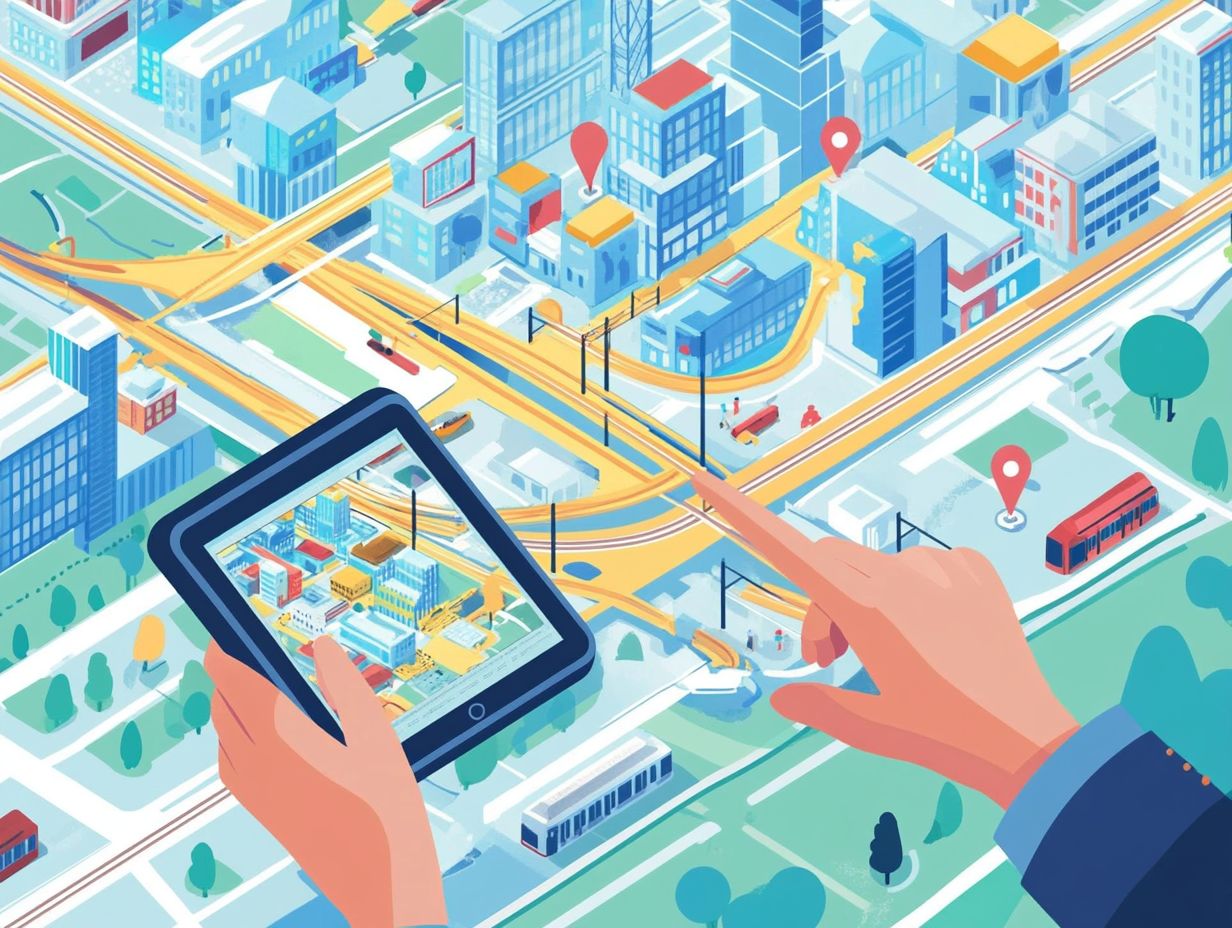In an era of increasing urbanization, the effectiveness of public transit systems and transportation networks have become more crucial than ever. Thoughtful transit planning can significantly enhance the commuting experience while also benefiting the environment. This article will explore how location data can be utilized to improve public transit planning, highlighting its advantages, challenges, and best practices. It will also examine inspiring examples of successful implementations and discuss the future of transit systems in the technological age. Finally, we will conclude with insights on the transformative power of location data in creating smarter and more sustainable public transportation solutions.
The Importance of Effective Public Transit Planning

Effective public transit planning is essential for enhancing urban mobility and ensuring that transportation networks are efficient, equitable, and accessible to all members of the community. This strategic decision-making process involves analyzing location data, demographic information, and engaging with stakeholders.
Successful public transit planning leads to integrated transport networks that provide seamless systems for commuters with diverse needs. It also determines the success of public transport initiatives, infrastructure development in terms of service frequency, ridership, and overall user experience.
Furthermore, public transit planning and operation serve as vital tools for achieving broader societal goals, such as environmental sustainability and urban accessibility and the reduction of traffic congestion.
Impact on Commuters and the Environment
Effective public transit planning significantly impacts commuters by positively influencing travel behavior and commuter trends, commute patterns, and overall user satisfaction with public transportation systems.
Well-planned public transit systems help reduce traffic congestion and minimize the environmental impact of travel, making public transportation a more attractive option than private vehicles. These initiatives serve a purpose beyond merely transporting people from one location to another; they are crucial for developing a robust and efficient transport network that caters to the specific needs of riders.
Enhanced service reliability allows commuters to accurately anticipate vehicle arrival and departure times, fostering trust and encouraging greater use of the services. Improved ridership forecasting mechanisms enable planners to predict peak ridership times and anticipate travel demand and provide increased service, leading to higher user satisfaction.
Furthermore, enhancing sustainability benefits not only commuters but also has a positive effect on community health and economic development and air quality, contributing to the greater goal of environmental sustainability.
Utilizing Location Data for Transit Planning
The Importance of Location Data in Transit Planning: Location data plays a crucial role in transit planning and transportation overall.
Transportation planners rely on this data to analyze ridership patterns, develop ridership models, optimize routes, and enhance the performance of public transit systems.
By utilizing Geographic Information Systems (GIS), planners can effectively visualize spatial data and perform spatial analysis, enabling them to make informed decisions.
This data-driven approach helps improve service reliability and allows planners to better address the needs of diverse urban populations.
Benefits of Using Location Data

The benefits of using location data in transit planning are numerous, including enhanced urban mobility and traffic congestion reduction.
- Operational Efficiency: By utilizing demographic insights, travel behavior analytics, and ridership analysis derived from location data, transit planners can design public transport systems that align with the needs of their communities and plan for future infrastructure requirements.
- Improved Service Delivery: Location data allows planners to optimize existing transport routes and schedules. This information helps authorities identify areas that are underserved, addressing service gaps and improving accessibility by public transport, facilitating targeted investments in transit infrastructure.
- Enhanced User Experience: Real-time location data provides transit authorities and users with up-to-the-minute information. This enables authorities to make necessary adjustments to schedules and routes while allowing users to make informed decisions about their travel plans.
- Promoting User Feedback: By gathering citizen feedback on transit systems and correlating it with location data analytics, planners can quickly pinpoint areas for improvement. Encouraging community input through surveys, meetings, or social media channels fosters a sense of ownership and trust among users, ultimately leading to more tailored and satisfactory transit services.
Challenges and Limitations
The challenges and limitations of location data in transit planning encompass issues related to data collection accuracy and bias, funding sources, transit equity, and policy making frameworks. Effectively addressing these challenges requires proactive engagement with stakeholders and the development of innovative solutions.
Accuracy of Collected Data:
Agencies must evaluate how accurately the data they collect reflects the realities of the communities they serve. Often, the data can exhibit biases that already exist within the systems they aim to improve. For instance, GPS data may underrepresent low-income areas, which can lead to the neglect of those regions’ transportation needs, impacting transit effectiveness and multimodal transport options during route planning. This issue is particularly concerning for agencies that rely heavily on private sector data vendors for location information.
Funding Sources:

Securing adequate funding poses significant challenges in achieving objectives such as integrating new technologies and ensuring comprehensive network coverage, particularly in low-income areas.
Equity of Transit:
Transit equity is essential for social justice; ensuring that marginalized and low-income communities and low-income communities have access to public transit is crucial for maintaining the health and safety of those populations.
Achieving equitable, accurate, and well-funded transit systems necessitates the involvement of stakeholders, including regional transit agencies and local government partnerships, including community members, local organizations, and policymakers. Engaging stakeholders and fostering community engagement is one of the most effective strategies to ensure that location data is utilized effectively in advancing public transportation and smart transportation initiatives.
Best Practices for Incorporating Location Data
Incorporating location data into transit planning involves data integration and using mapping tools implementing best practices that ensure the data is used effectively to enhance both the community impact of services and their overall effectiveness.
Data Visualization: Techniques such as GIS maps, charts, and graphs are employed to communicate the results of data analysis to stakeholders and the public. These visual tools also represent user feedback related to the location of services and service coverage.
User Engagement: Actively seeking user input on service routes and locations is essential for accurately assessing user needs before making decisions. This process can uncover community-specific issues and may involve surveying users, conducting focus groups, and engaging in joint decision-making with users and stakeholders to select potential bus stops and shelters.
Safety Assessments: Evaluating the safety of proposed bus stop, station, and shelter locations is a critical aspect of the transit planning process. Various criteria, such as traffic volume, accident risk, pedestrian visibility, and proximity to safe waiting areas, are used to assess safety and ensure public safety. Along with technical data, user feedback regarding factors like lighting and visibility is also taken into account, informing decisions about the location and design of transit stops and shelters.
Examples of Successful Implementation

Numerous examples demonstrate the successful application of location data in transit planning. Cities employing data-driven methods to enhance transit hubs, improve interconnectivity, and promote smart city development underscore the significance of capital investment and innovative solutions.
For instance, Barcelona integrated real-time tracking and location data into its public transport system, resulting in enhanced route efficiency and reduced passenger wait times. This led to a dramatic improvement in user satisfaction and a substantial increase in community participation in transit initiatives, indicating strong public approval of the enhancements.
Similarly, Chicago’s implementation of GIS mapping and location tracking technologies to optimize bus routes achieved a 50% reduction in operational costs and a corresponding increase in service reliability. Collectively, these examples highlight the positive outcomes of leveraging location data and using routing algorithms and its crucial role as a foundational element of smart urban environments.
Future of Public Transit Planning with Location Data
The future of public transit planning will be significantly influenced by location data, data analytics, and data visualization and technology, resulting in innovative solutions such as Mobility as a Service (MaaS) and enhanced data-driven decision-making.
This evolution will prioritize improved sustainability and operational efficiency, ultimately creating more responsive and user-centric public transportation systems.
Technological Advancements and Potential Impact
Technological innovations, such as real-time data analytics and mobile applications, are poised to transform public transit planning by providing valuable insights into user satisfaction and trip planning, fare systems, and service reliability, service reliability, and operational efficiency.
These innovations will enable a more responsive transit system that adapts to evolving commuter demands and enhances the overall travel experience.
By utilizing sophisticated algorithms and data processing capabilities, transit authorities can analyze traffic patterns, predict peak usage times, and adjust schedules accordingly. This proactive approach, incorporating advanced transit planning and demand forecasting, not only optimizes service delivery but also significantly reduces wait times, overcrowding, and traffic congestion, ultimately improving service reliability and operational efficiency.
User-friendly mobile applications give commuters access to timely information, allowing them to plan their journeys more effectively. These tools leverage real-time tracking, data analytics, and GIS mapping to enhance user experience and accessibility, facilitating better travel demand management and route optimization.
Such enhancements are essential for fostering higher engagement levels among passengers and ensuring that public transit remains a viable option compared to private transportation. The integration of geographic information systems and data visualization aids in understanding passenger behavior, commuter trends, and travel patterns, contributing to more effective transit-oriented development and community engagement.
Ultimately, the integration of these technologies contributes to a more sustainable and user-centric transit ecosystem. By promoting environmental sustainability and equity in transit through advanced transport models and smart transportation solutions, transit agencies can better address infrastructure development and urban planning needs.





